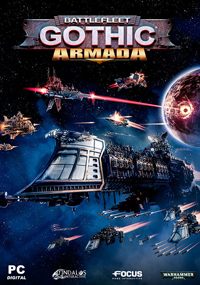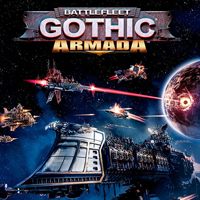Battlefleet Gothic: Armada Review – Age of Sail 40K
The already impressive number of productions set in the Warhammer 40K universe has just been augmented with another interesting title. Battlefleet Gothic: Armada – a digital rendition of a 1999’s board game – is some truly good tactical RTS.
The review is based on the PC version.
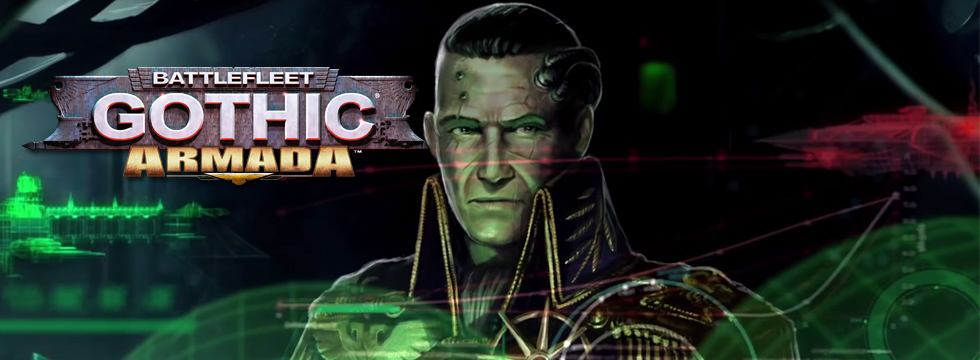
- Awesome design of the battleships;
- Each of the four factions plays totally different;
- Dynamic and highly tactical battles;
- Developing the fleet while progressing in the game;
- Nice graphics;
- Interesting solo campaign.
- Inconsistent difficulty of the battles, different for attackers and defenders;
- Rather limited multiplayer options;
- Empty battlefields.
The universe of Warhammer 40K can be pretty much summed up in one word: “eclectic”. Here, medieval themes are blended with dark sci-fi, and modern technology exists next to magic and theocratic reign of the immortal emperor. Widespread political turmoil leads the galactic community to countless wars, in which whole planetary systems are involved. In Battlefleet: Gothic Armada, the player takes control of an interstellar fleet of one of the four factions: The Empire, Chaos, Orks, and Eldar, and is thrown into the middle of a struggle for the control over the Gothic sector – the heart of the human civilization.
Space duels
The key feature of gameplay in Battlefleet Gothic: Armada are real-time battles played in space, on square, 2D battlefields. The player usually has a couple of line ships under his command – cruisers of different classes and battleships, as well as smaller escort ships – destroyers, frigates and so on. Before the battle, the player can chose which ships does he want to use, having a defined sum of tones to share between the units. We command the fleet both in macro (by planning the general draft of the attack) and micro scale (making sure individual units use their full potential). A Rambo-style charge will rarely be of any profit.
Despite having relatively few ships under our command, there isn’t much time to marvel at the vistas during the battles as we are busy setting courses, marking targets and running ships’ systems. Since the ships are equipped with different weapons located in different parts of the vessels, the right distance of attack has to be maintained, as well as a proper positioning of the ship in relation to the enemy – some ships have their weapons in the bow, others in broadsides, armor has different values on different sides as well. Some of the orders that otherwise have to be issued manually can be automated, which is especially useful in case of smaller escort units. Maneuvers are crucial; even a powerful battleship can go down in defeat if it’s surrounded by smaller and quicker units that can stay out of its field of fire.
The battles are fast-paced and spectacular so the player is constantly verifying the strategy. It becomes even more complex, if you add special actions to the equation: using bombs and torpedoes, rapid maneuvers with boosters, warp-jumps, and many more things. To make issuing all these orders even possible, the game has an active-pause system (which it technically isn’t, since the time only slows down; not stops), accessible by hitting spacebar. Battles of Battlefleet Gothic: Armada aren’t the easiest, but manage to provide much fun thanks to brilliant and complex tactical layer and a fast pace. Another big advantage is the variety among the factions. The Empire is all about heavy broadside weapons and good armor, but the ships pay the price in speed. Chaos forces have much greater range of fire, but their firepower isn’t as big, and the ships not that resilient. The Orks, a race which is flying around in piles of space junk taped and screwed together into starships, have undisciplined crews, and the accuracy of a blind man shooting during an earthquake, but since there’s not much left that can break on their ships anyway, they aren’t afraid of ramming everyone in their way. The Eldar corsairs have incredibly quick and agile ships fitted with cutting-edge pulsar cannons, and very disciplined crews, but as soon as they stop moving, they become an easy prey. This variety makes commanding different factions a totally different experience, and considerably prolongs the time that can be spent with this game.
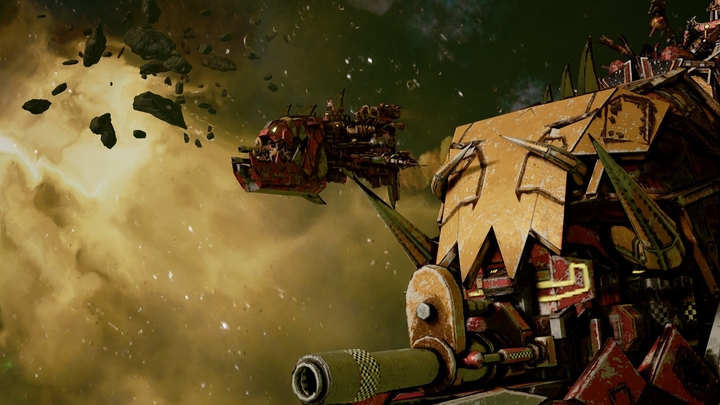
The main type of battle is the clash of battleships, where the only goal is to achieve tactical superiority over the enemy forces, i.e. to tear their fleet apart. There are other modes as well, where we’re playing either as a defender or an attacker. There, we can be given one of several objectives such as escorting a convoy, coordinating a planetary airstrike, extracting data from the enemy flagship, destroying defensive platforms, or eliminating a specified unit. Unfortunately, despite seemingly wide range of missions, it doesn’t always work well in practice. The biggest issue with those modes is the fact that the difficulty depends on faction and role of attacker/defender. For example, looking after painfully slow transport ships when the attackers are Eldar, is sometimes sheer impossibility. The Eldar also have the upper hand when a task requires quick retreat after completing the objective (as in data extraction). On the other hand, playing as the attacker boils down to throwing every available unit at the enemy before they manage to commence a warp-jump. Another problem with these missions is the choice of the mission objectives themselves; they sometimes feel somewhat artificial, and bring about odd tactical implications. For example, in planetary airstrike mission the task is to get to three different sectors of the map in time, thus causing a ray-from-nowhere to be fired at the planet. It’s hard not to give in to the impression that the devs just didn’t actually know what to do here. The above issues wouldn’t be too off-putting if those missions only appeared once in a while, as a diversion from the main battles. However, they are often chosen by the computer both in single- and multiplayer, and soon become irritating.
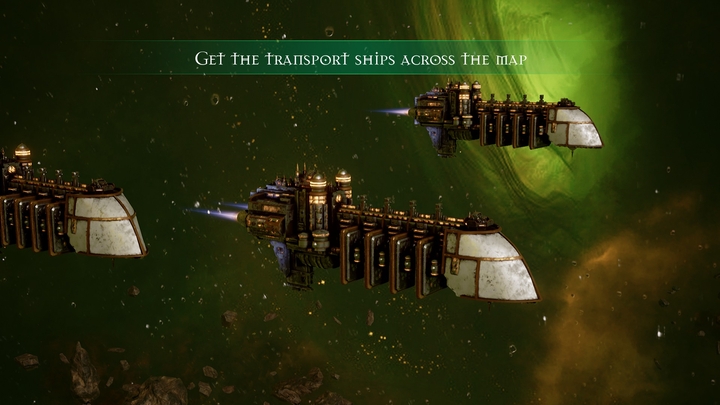
The interface can be a bit confusing at the beginning. A compact context menu that would appear next to the selected ship would make things a whole lot more convenient. Until we master shortcuts and hotkeys, frenetic round-trips from the orders menu onto the battlefield will be the rule of the day.
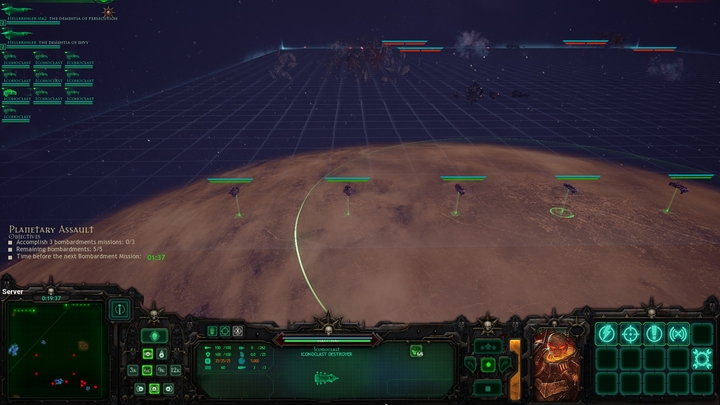
A dinner for one
In Battlefleet: Gothic Armada we’re able to compete against the AI in the singleplayer, as well as versus real players, online. There is a campaign mode, where subsequent missions are intertwined with an interesting story, told by an admiral of the Imperial Fleet. Apart from that, there’s the skirmish mode, where we can collect Renown points and develop our fleet. This mode is virtually identical in both the single- and multiplayer. The player has to take care of their ships, but the fleet grows more powerful with each success. Losing a ship during a battle means it will unavailable for the next two games. The developers have indeed catered to singleplayer fans, which may come as a surprise considering the trends driving the industry nowadays. Sadly, it comes at the price of a rather poor multiplayer. As a matter of fact, there’s no way to change the parameters of a game – things like map, mode, and enemies are randomized. The player can only specify whether they want to play 1v1 or 2v2. There’s no lobby at all, no leaderboards, ranks, alliances, avatars, chatroom – not a thing. I hope that upcoming updates will add more functionalities (or any functionalities, for that matter), because right now, the multiplayer is (to put it mildly) raw.
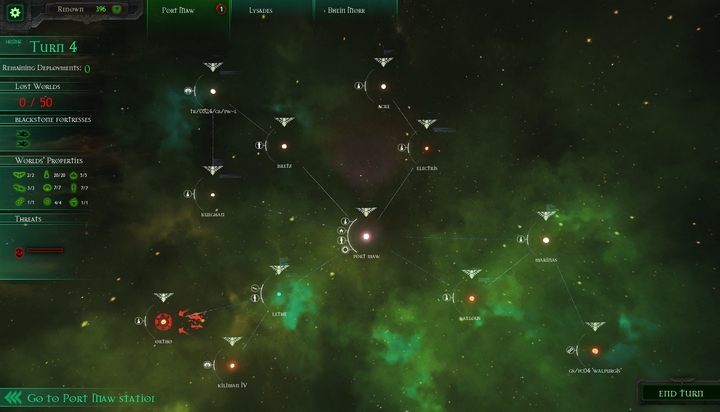
Flying cathedrals
Visually, the biggest asset of B:GA are the beautiful, majestic ship designs, based on the miniatures form the board game. The models were created with an incredible attention to detail, and a great sense of taste. I would often hit F10 to turn off the HUD and behold those beasts using the cinematic camera. I found the Imperial units particularly spectacular – they look like gothic churches with their soaring towers, domes, and stained windows, all fitted into an armored hull and powered by tremendous engines. Eldar ships are no worse – graceful machines, stretching out the solar sails. And then, in contrast to this marriage of dreams of an architect and an engineer, there are the Orc ships – a mass of junk and ill-fitted parts that, along with their names full of orthographic mistakes, create a cheery atmosphere of a parody.
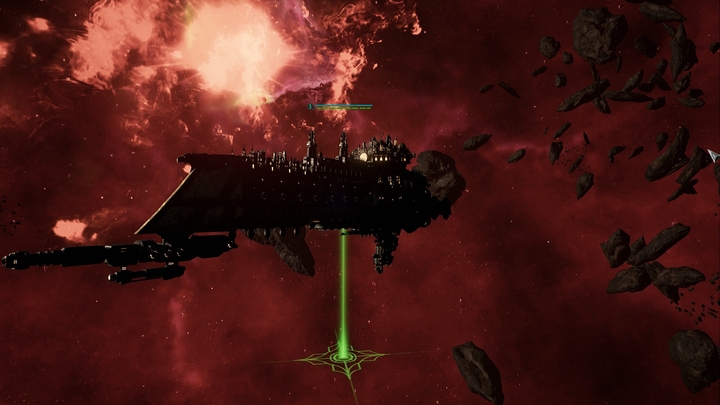
Unfortunately, the same can’t be said about the battlefields, which are conspicuously empty. The devs must have been inspired by the shapes of states in the US, and used a ruler to designate the battlefields. It creates an impression that the battles are not waged in real space, but rather on space boxing rings. There are only two types of natural objects that can appear in the area of operations: nebulae, or gas clouds, which can obscure ships, and asteroids, which damage hulls. All bigger objects, such as space stations and planets, are in the background, and can’t be reached. But if we forget about those limitations, there truly is a pretty piece of vibrant galaxy full of stars to see here. It was all achieved within a pretty well optimized software, allowing the game to run on high details even on less powerful PCs.
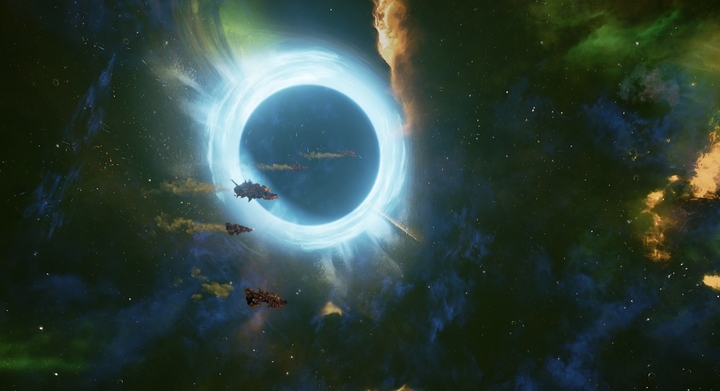
The Emperor would be pleased
Battlefleet Gothic: Armada certainly is an interesting, and – more importantly – a successful attempt at converting a board game into a full-blown RTS. Battles are dynamic, and the ships are masterpieces of visual design. Nice campaign mode and decent fleet development mechanics give a reason enough to stick with this game for a while. Hopefully, the developers will keep expanding and polishing this game which, being already pretty decent as it is, still holds a lot of potential. I can recommend Battlefleet: Gothic Armada, with clear conscience, not only to the fans of Warhammer: 40K, but to all those who love RTS games as well.
Battlefleet Gothic: Armada
Battlefleet Gothic: Armada Review – Age of Sail 40K
The already impressive number of productions set in the Warhammer 40K universe has just been augmented with another interesting title. Battlefleet Gothic: Armada – a digital rendition of a 1999’s board game – is some truly good tactical RTS.
